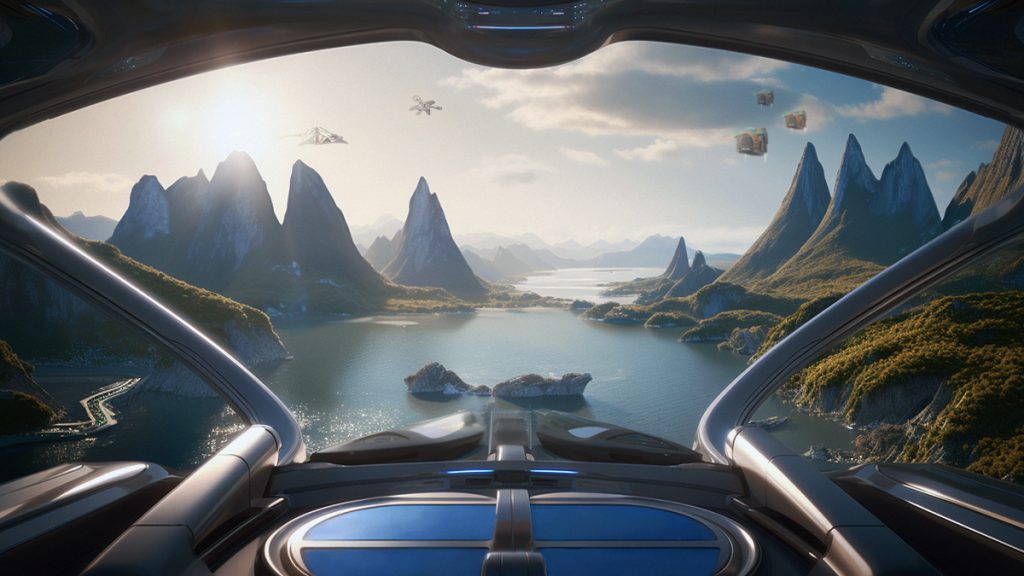Since we discovered Arcadia in 2019, technological advancements have facilitated the exploration and preservation of this parallel world.
Advanced data transmission techniques through the Earth-Arcadia Tunnel have allowed us to create physical objects within Arcadia, primarily in the form of exploration and preservation technologies. The development of tools such as the LX1 space rover, Spirit of the Skies Loader Class (SOSlc) vehicles, and Kestrel Ex Mini drones enhances our exploration of Arcadia. These innovations not only broaden our understanding of Arcadia and other parallel worlds but also help preserve their structural and historical integrity. By enabling users to remotely explore a world as though they were back in time, we enhance and immerse them in their journey. These innovations also demonstrate the potential of digital engineering in parallel world exploration.
Our first remotely printed structure was the Einvaldi spaceport, situated at the opening of the Earth-Arcadia Tunnel on the Arcadian side. Following this, we developed the LX1, a sophisticated space rover, to investigate Arcadia. LX1’s collection of artifacts and relevant data, including Echoes – poems inscribed on stone tablets scattered around Arcadia, have provided invaluable insights into Arcadia’s history, culture, and society. NeoWorlder’s innovation and scientific brilliance are further demonstrated through LX1’s mini rovers, sent to prospect the underworld, as LX1’s size and design are not suited for such areas.
In addition to the LX1 rover, ThemeWorlder’s suite of exploration technology includes the Spirit of the Skies Loader Class (SOSlc) Vehicles. These remotely operated vehicles play a pivotal role in preserving Arcadia’s dilapidated structures using a process called polymer sleeve placement. By replicating building structures through the EAT and placing the replica (polymer sleeve) over the original building, we enhance the virtual simulation experience for users while preserving the integrity of historic structures. The SOSlc vehicles, equipped with advanced navigation and levitation technology, enable the safe and efficient transportation of these materials. NeoWorlder has also adapted these vehicles for various virtual environments, where users can use them for transportation around the world or even race one another, providing a firsthand experience of flying SOSlc vehicles.
Another integral component is the Spirit of the Skies Flatbed, key to our 3D printing operations. Serving as a holding area, it allows materialized objects to solidify before transport, thus ensuring their structural integrity. Located in the larger dome of the Einvaldi spaceport, this loader bed is where objects are placed after being printed. They remain there for approximately a week before being moved by the Spirit of the Skies Loader vehicles. This waiting period preserves the structural integrity of the materialized objects, as transporting them prematurely could weaken them. The Loader vehicles then place the objects at their designated locations in Arcadia, demonstrating the precision, thought, and care that go into replicating or creating new objects in Arcadia.
Finally, we introduce the Kestrel Ex Mini drone. Docked on the LX1 rover, this advanced exploration tool, fitted with LIDAR and DOF cameras, enables efficient and accurate data collection over large areas of Arcadia. The drone’s waterproof design and silent, tri-blade toroidal propellers facilitate underwater exploration, further enhancing our understanding of Arcadia’s diverse landscapes. While it is designed to go high up, Einvaldi deploys drones built specifically to explore Arcadia’s spatial objects.
Our diverse range of technology represents a significant contribution to the exploration and preservation of Arcadia, demonstrating the immense potential of digital engineering in parallel world exploration. These advancements not only showcase ThemeWorlder’s skill in crafting these state-of-the-art tools, each serving a crucial purpose in our mission, but they also enrich our knowledge of Arcadia and open new avenues for future exploration endeavors.



